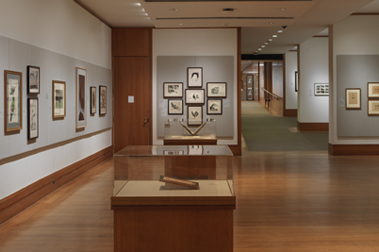Saint Francis Kneeling in a Grotto, holding a Book and a Skull
Nicolaas van der Horst Flemish
Not on view
This image of Saint Francis of Assisi is a design for the opening page (half-title) of Jean Puget de la Serre’s 1627 devotional book Les douces pensées de la mort—the title appearing on the open pages of the volume held by the kneeling saint.[1] Les douces pensées de la mort, a meditation on death as the emancipation of the soul from worldly concerns and suffering, invokes Saint Francis twice: briefly in Chapter One and at greater length in Chapter Two, where he is praised for his devotion to Christ and where the ecstasy that followed his stigmatization is equated with death. The book is the first of several by Puget de la Serre for which Van der Horst designed illustrations, many of them, like the present example, engraved by Cornelis Galle I (1576-1650).[2]
The image was also reproduced in another engraving, signed “C. Galle,” in the same orientation as the drawing and bearing, in place of the title of Puget de la Serre’s book, a phrase in Latin derived from Galatians 6: “absit mihi gloriari nihi in crvce domini nostril iesv Christi.” There is an impression in the Graphic Art Collection of Göttweig Abbey in Austria.
(JSS, 8/23/2018)
[1] Jean Puget de la Serre, Les douces pensées de la mort (Brussels: 1627). A copy of this original edition with the intact half-title is in the library of Ghent University (https://lib.ugent.be/catalog/bkt01:000403207).
[2] Véronique Meyer, “Un auteur du XVIIe siècle et l’illustration de ses livres: Jean Puget de la Serre (1595-1665),” in Bibliothèque de l'École des chartes 158, no. 1 (Jan-June 2000), pp. 35-38.
This image cannot be enlarged, viewed at full screen, or downloaded.


